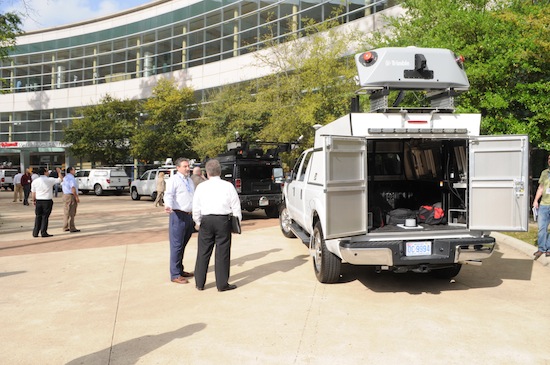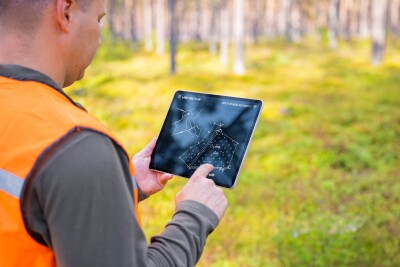Cal-Davis studies show cost efficiency, accuracy limits
DAVIS, Calif. – Researchers here at the University of California-Davis’ Department of Mechanical and Aerospace Engineering released recently two studies that represent perhaps the most in-depth information currently available about mobile laser mapping and survey. Performed for the Washington and California departments of transportation, respectively, the two reports look at the cost-effectiveness of mobile laser scanning for geospatial data gathering and the efficacy of using mobile laser scanning to produce terrain models of pavement surfaces.
Find the Caltrans report here.
Both reports provide a wide-ranging look at currently available mobile scanning technology and offer up best practices for performing the scanning work and for evaluating the performance of those doing the work.
Ray Mandli, head of Mandli Communications, which has been involved in using lidar for transportation mapping and survey work for the past three years, participated in the studies and said he downloaded the reports on the day of their release. “I think it’s the best compilation we have in the industry right now of what we had available 12 months ago,” he said, noting that while the available technology may have changed slightly, he feels the information about best practices may be valuable for three to five years.
“It shows a very clear understanding of the technology,” Mandli said. “I’ve been recommending it to everybody.”
UC-Davis researcher Kin Yen, in an interview with SPAR, said the WashDOT report is getting more attention because it shows a pretty clear cost-savings when using mobile laser scanning vs. traditional methods of gathering inventories of roadside features, bridge clearance data, and Americans with Disabilities Act feature inventories, as WashDOT is currently required to do. Depending on the mobile lidar deployment option – buying vs. leasing, mapping grade vs. survey grade, etc. – the study showed WashDOT could save between $1.3 million and $6.1 million over the course of six years.
“I think the WashDOT report clearly shows that there are dollars savings that would benefit them,” Yen said, though he did note that there could be some hidden costs involved with re-organizing the department to take advantage of all the data collection efficiencies mobile scanning offers. “It would depend on how they implement it,” he said.
One thing that surprised him a little, he said, and may come as a surprise to those investigating the technology themselves, is that, though the systems are expensive, the actual hardware doesn’t end up comprising all that much of a mobile scanning operation’s cost. “For people complaining or concerned with the cost of the systems,” Yen said, “while it’s not small change, when you look at the entire project, the operating cost, the personnel and the post-processing cost, the cost of the equipment is only like 10 to 20 percent of the overall cost. It’s comparatively small.”
The Caltrans study investigates a much more specific scenario: Can mobile laser scanning get the accuracy needed to perform a competent freeway surface survey? As the report’s introduction notes, “a freeway pavement surface survey is the most hazardous task that Caltrans surveyors face.” If that could be replaced by a car driving at freeway speeds it would certainly be appealing to departments of transportation the world over.
The problem? The current positional accuracy specified in the Surveys Manual for pavement is 10mm horizontal and 7mm vertical for hard surfaces. Caltrans investigation of photogrammetry has already led them to conclude that its decimeter-level accuracy just won’t suffice. Would mobile laser scanning?
Well, technically, no. By Caltrans’ strict requirements, “it does not meet that,” said Yen. “And I don’t think anyone would argue that. Whether that’s actually required accuracy for pavement survey, that is an open question … A lot of people would argue that spec is too strict, and they can live with a looser tolerance.”
Do those people all manufacture mobile laser scanning systems?
Yen laughed. “I think even the surveyors have a sense that this is probably good enough,” he said. “A lot of them are on the fence in terms of mobile technology. A lot of them think it’s good enough to do what they need to do, but a lot of them say, ‘well, it doesn’t quite meet the spec, so I’m not sure about that.’”
One of the other issues with mobile laser scanning, which also seems unquestioned, is that the skill of the operator, the workflow, the procedures, the post-processing, all of these affect the quality of the data and the accuracy. “The problem,” said Yen, “is that someone could really screw it up, and so that was one of the lingering concerns.”
Further, if you’re in a GPS-challenged area, like a crowded downtown area, “your error can go up, and you can’t really tell how the error goes up.” Especially considering that these tight spaces are where the traditional surveying work is most dangerous, that’s a problem.
Add to this that the work being done with the mobile scanner is likely contracted work, where margin is important to the service provider and the quality of the data is important to the department of transportation, and both sides might be a little uneasy.
Still, the report’s conclusion is pretty straightforward: “Under the right conditions and using good methodology, [mobile laser scanning]can be used to create DTMS of pavement surfaces.” Further, the best practices and methodology for control and pilot testing should prove very valuable for anyone working in this area.
Of course, service providers like Mandli have been converts for some time now, but they’ve been having varying degrees of success with convincing those who need the data that this is a reliable way to collect it. “A lot of people just haven’t been exposed to [mobile laser scanning],” he said, “and that’s what this report does. It gives you a concept of how it actually works.”
“This is a nice Christmas present.”






